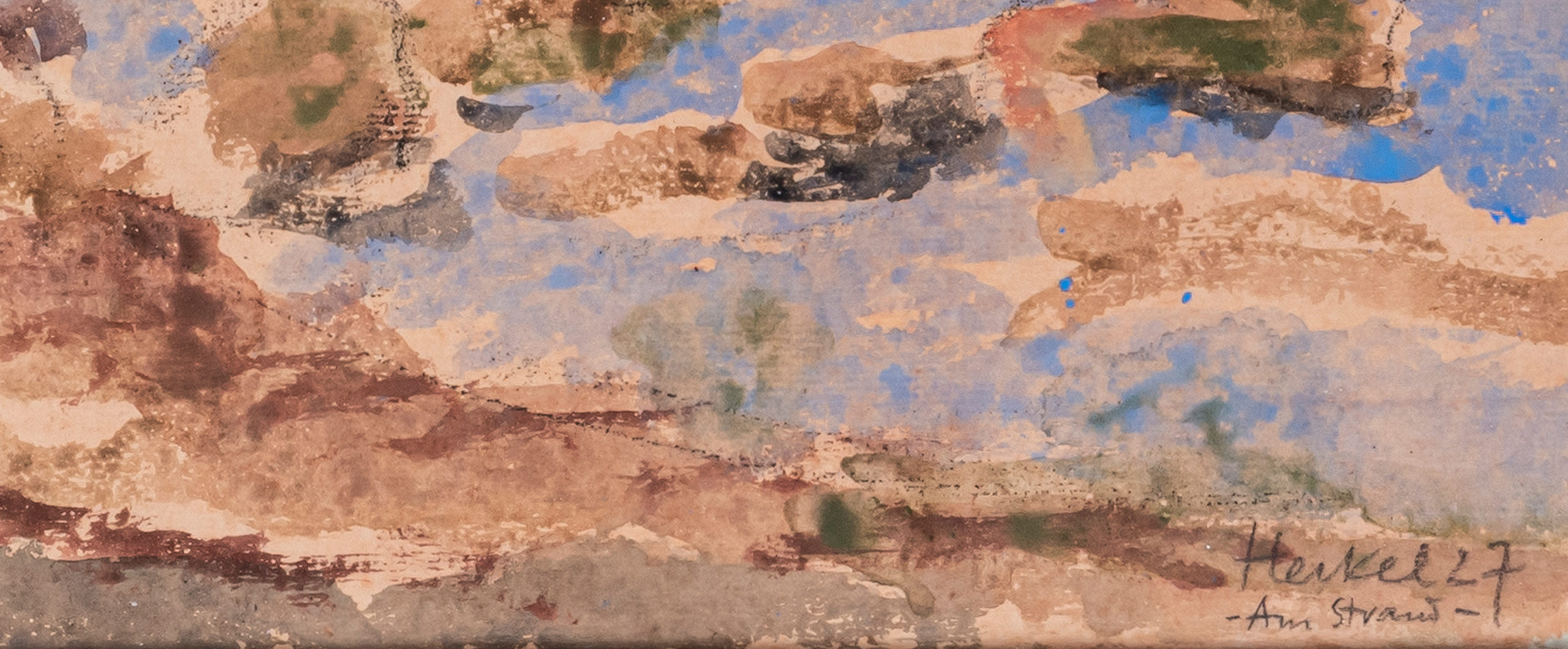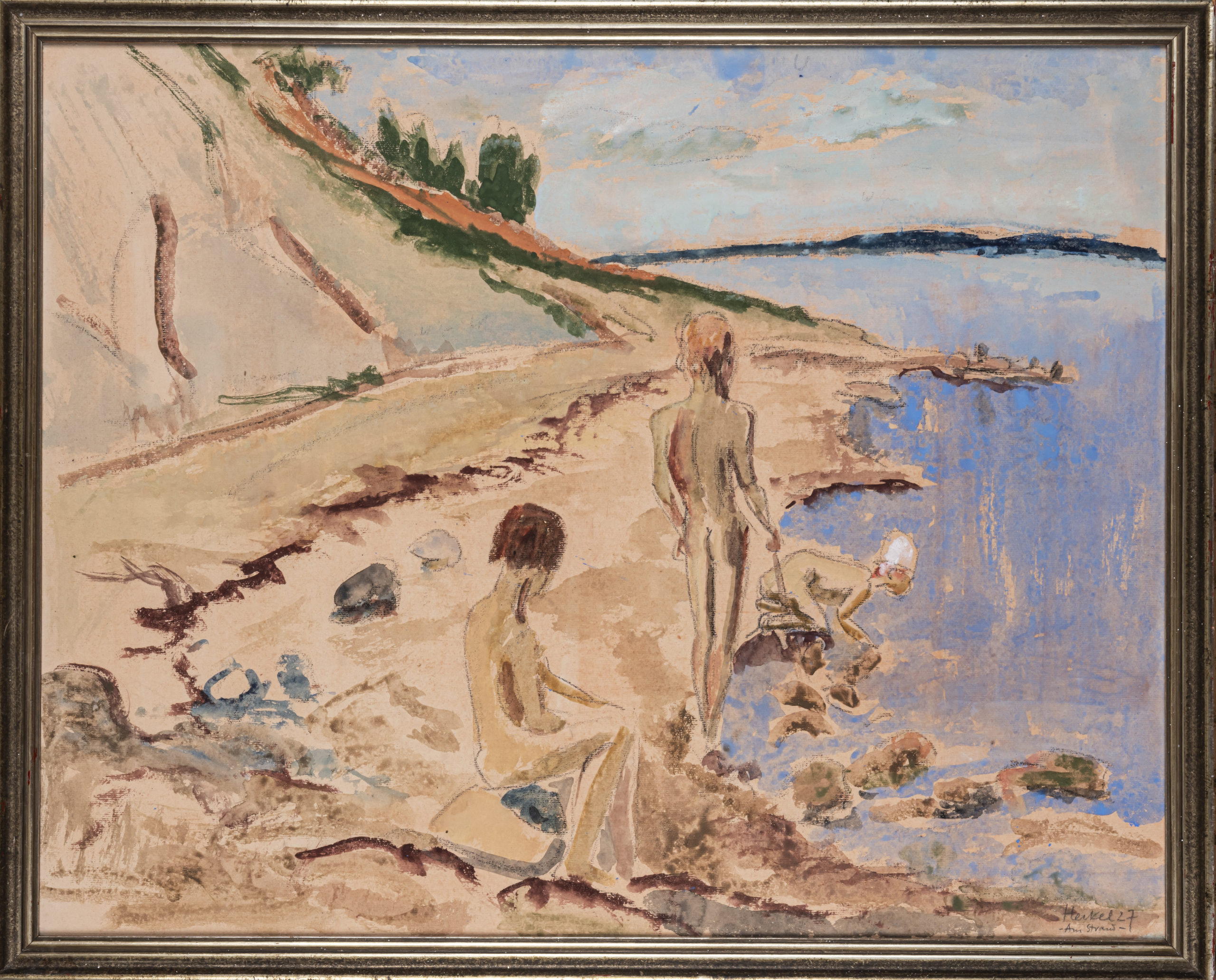
Erich Heckel
‘Am Strand’
Born in the summer of 1883 as the son of a railway engineer, Erich Heckel began his first painting excursions when he was barely twenty years old. He had been friends with the slightly younger Karl Schmidt-Rottluff since 1901, and the two began to combine smaller trips with their passion for creating art. Like his fellow students at the Technical University of Dresden, Ernst Ludwig Kirchner, Fritz Bleyl and Karl Schmidt-Rottluff, who joined them somewhat later, Heckel acquired his skills as an autodidact. In 1905, the four architecture students founded the artists’ group ‘Die Brücke’ (The Bridge), in which they sought new artistic means of expression for their alternative life plans. The artists’ association expanded in the following years to include passive members and was primarily intended to serve the purpose of an exhibition community; numerous traveling exhibitions of the group took place. In 1907 Heckel went to the coast for the first time for a longer painting stay. Together with Schmidt-Rottluff he spent several weeks in Dangast at the North Sea, to which he returned again and again. During these longer stays at the German Sea with his artist friends until 1910, trips to Italy and summer resorts at the Moritzburg ponds near Dresden, he worked intensively in prints and paintings on the theme of the nude in free movement, among other things. The shoreline landscapes take on an enormously lively character through expressive coloration; faces are spontaneously captured with wild, gestural brush or ink pen strokes. The typical group style of Expressionism of the ‘Brücke’ developed. In 1911 Heckel traveled to the Baltic Sea for the first time in the company of the dancer Sidi Riha (called Siddi), who from then on became his most important model and his lifelong partner. After a close studio relationship with Kirchner in Dresden, he and Siddi moved to Berlin in 1911, where they met and became friends with other Expressionist artists such as Lyonel Feininger, August Macke, and Franz Marc.
After the dissolution of ‘Der Brücke’ in 1913, Heckel continued to concentrate on his art and exhibitions with art dealers such as Fritz Gurlitt. During the war years Heckel performed medical service in Flanders, where he was encouraged by the head of the medical platoon, an employee of the Berlin National Gallery, Walter Kaesbach, repeatedly given small spaces for his artistic work.
After the end of the war Heckel again traveled with Siddi to the Baltic Sea. In the town of Osterholz on the already familiar Flensburg Fjord, they purchased an old farmhouse, which was to serve as their summer and fall residence and in whose upper floor they set up a studio space. While working in Berlin in the winter and using the spring for trips to the south, the couple visited Osterholz in the same annual routine until 1929. Often the children of Heckel’s sisters or friends were inserted into the motif to make the coastal scenes more lively.
In this auction we can offer his work ‘Am Strand’. The so-called ‘summer children’ also enrich the shore scene in this work on paper. The artist depicted the three unclothed figures in different postures. The two in the foreground of the picture observe the immersed play of the kneeling one on the stones in poses turned away from the viewer of the picture, so that we, as the audience outside the picture, can easily join these unbiased looks and thus advance ourselves to the immanent viewer of the picture.
Heckel occupied himself with these natural beach motifs around Osterholz until 1939 when he gave up his studio there. However, the artist returned to the Baltic Sea again and again until the mid-1940s. Despite signing the ‘Aufruf der Kulturschaffenden’ in 1934, in which the ‘allegiance of the Führer’ was affirmed, Heckel was banned from exhibiting in 1937 and his works were confiscated during the ‘Degenerate Art’ operation, some even destroyed. In 1944 he moved to Hemmenhofen at Lake Constance and spent the years until the end of his life there. From 1949 to 1955 he took on a teaching position at the Academy of Fine Arts in Karlsruhe, but he turned down a teaching position at the Academy in Berlin. Heckel was a participant in documenta 1 in 1955.

